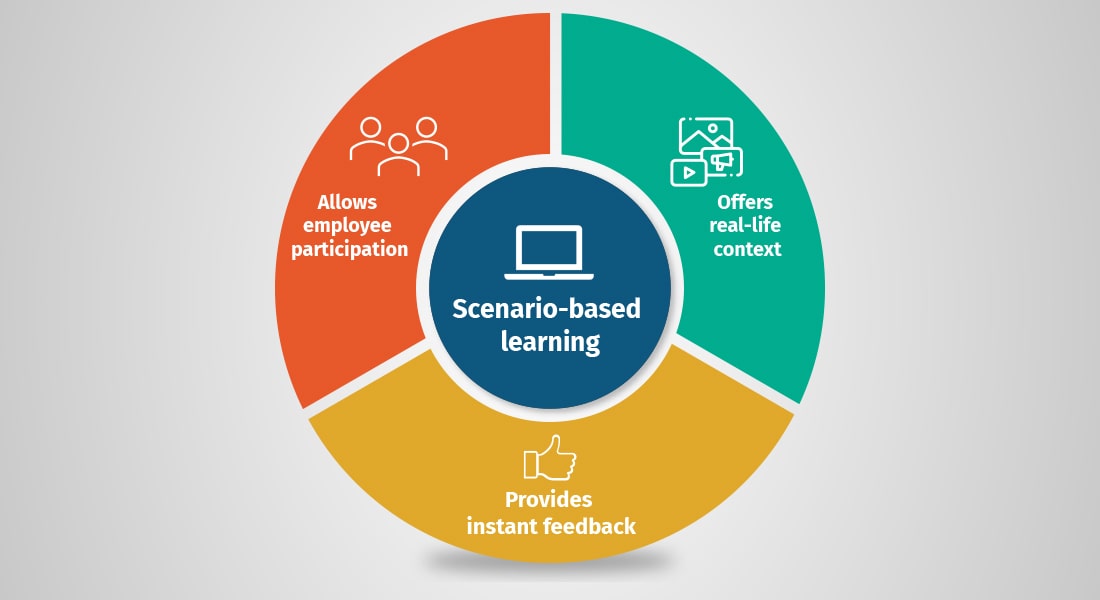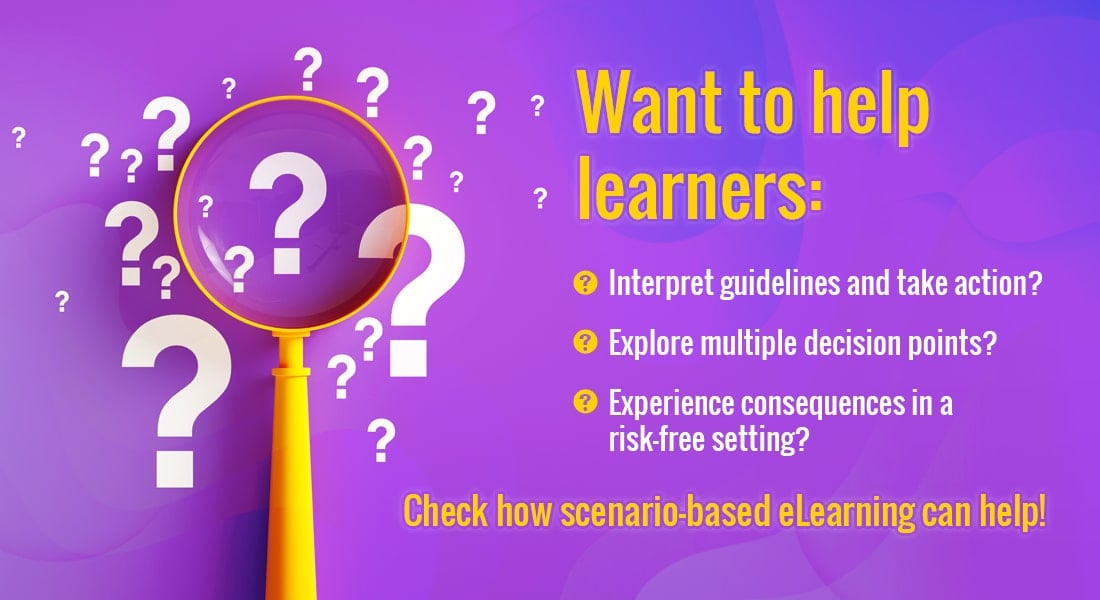The ‘Why’ and ‘How’ of Scenarios in eLearning

Online training for many employees is limited to attending mandatory sessions, mainly for the sake of getting promotions or perks. But organizations can’t really afford to conduct training just for the sake of ticking it off from their ‘to do’ list, without employees actually learning from the experience. Hence, L&D managers are constantly struggling to engage employees and make them feel more involved in their own learning. A great learning experience helps learners absorb content better and hone their skills to solve real-world business challenges. And using scenarios in eLearning is a great way to generate empathy and engage employees in the training.
Explore ways to incorporate adult learning principles in online training!
Scenarios provide learners an experiential learning experience where they ‘learn by doing’. The content in this learner-centric methodology has relevance to the learner’s real world, and so it enables them to relate to the information and absorb it better, and also remember it for a longer period, making learning that much more effective.
Benefits of Scenarios in eLearning
With scenarios:
- Offer learners a taste of the real world
- Facilitate learning by doing
- Reinforce learning with immediate feedback
Scenarios-based eLearning
Scenarios are a popular methodology used in e-learning. They are based on real-life situations, issues at work, or unique problems faced by employees in the workplace. Explaining a topic with the help of characters and settings that learners can relate to, makes the content easy to understand. Real-life scenarios also help build learners’ decision-making skills and improve their critical thinking.
An online sales training session, for instance, can be made more engaging by giving sales trainees a glimpse of the real world with the help of scenarios. Though sales training covers a myriad of topics such as industry overview, the organization’s sales process, dos and don’ts, product features, and competitor analysis, scenarios are especially useful to take learners through the process of how to sell the product to prospective customers, dealing with customer feedback, and more.

For example, animated characters can be used to show how missing an important step in the sales process could result in customer dissatisfaction, loss of deal, or worse, damage to the company’s reputation. Sales reps can also be taken through different realistic scenarios where they need to make important decisions and face the consequences of their decisions (whether right or wrong) in a safe risk-free environment.
The Many Benefits of Using Scenarios
We’ve already seen that scenarios help learners develop critical thinking and decision-making skills. But those are just two of the many uses of scenarios in e-learning. Let’s take a look at some more benefits of scenarios.
Scenarios in eLearning
Invite employee participation
Including scenarios in online training makes the whole learning experience fun and engaging for learners. They will no longer passively sit through the course but will actively interact with the content through scenarios they can are relate to.
With problems to solve, decisions to make, and outcomes to face, learners become active participants of their training, which enables them to build their knowledge and skillsets for their jobs.
Provide a glance into the real world
It can be a real challenge for training and L&D managers to get learners to pay attention to an e-learning course. But these sessions are crucial as they prepare employees for their job roles and help improve their performance. Including real-world problems that are both immersive and relatable, will not only grab the learners’ attention but also put them right in the middle of the situation.
This will help them build and exercise their decision-making skills in a risk- and judgment-free environment, with every decision they make only increasing their learning to directly help them in their job and daily tasks.
Offer scope for immediate feedback
Scenario-based eLearning stimulates learners’ minds. The decisions they make during the course or assessments will show them the consequences (both good and bad) of their actions, enabling them to hone their decision-making skills through the feedback that is provided. Immediate feedback helps employees learn new skills, change incorrect work patterns, and perform better on the job.

Tips to Design Engaging eLearning Scenarios
Here are a few easy tips that will help you formulate engaging scenarios for e-learners.
Understand the learner
The first step in designing a scenario-based eLearning course is to learn about the learners themselves – their background, work environment, job requirements, and the struggles they face on a day to day basis at work. All this information must be used to design scenarios – with characters similar to the learners, workplace tasks, and problems similar to their real-life ones; and so on.
Design relevant scenarios
Scenarios do make learning interesting for learners, but what makes them extremely fascinating is when they have relevance to the learners, and their problems at the workplace or in the field (e.g., customer facing situations for sales representatives).
You will find the line managers and immediate supervisors of the learners to be great sources of content to build relevant scenarios. Adding relatable characters, and building a story around it would be highly intriguing to the learners.
Use tools to make scenarios interactive
Authoring tools such as iSpring, Elucidit, BranchTrack, and Twine can be used to enhance the e-learning experience. The ‘Add Background’ feature in iSpring for instance enables course creators to boost engagement by adding realistic and high-quality images of offices, manufacturing warehouses, etc.
Not only does this make the scenarios interactive but also helps learners put themselves in the character’s shoes. Another frequently forgotten but important point to help learners retain course content is to use direct speech. Additionally, informal conversational language too enlivens the most boring scenarios.
Final Thoughts
Using scenarios in online training makes it an effective instructional strategy for engaging learners, and creating high-performing employees for the organization. This blog highlights how scenarios will benefit your organization and help you create courses that offer employees a hands-on approach to learning. Add them to your online training courses and watch your employees jump right in and apply their knowledge to solve real-world business challenges.
To further understand how experiential learning will benefit your employees and organization, don’t forget to get this webinar recording now.





